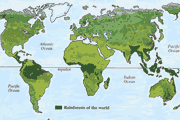|
We all know a few facts about rain forests from Tarzan movies; for instance, in the rain forest you will find lush green vegetation, exotic animals, restless natives, and usually a few white men up to no good. But beyond those stereotypes, what are the real rainforest facts? What is the status of the world's rain forests, and why is it important to preserve them? Well, buckle up, Jane—you get 'em rain forest facts now....
|
|
PARTS IN THIS SERIES
1. Rain Forest Facts
2. Rain Forest Destruction
3. Save the Rain Forest
Article 3 will appear on Grinning Planet later in 2008. Sign up for our mailing list so you're sure not to miss it!
|
|
Here's the first rainforest fact: Rain forests are the oldest ecosystems on earth—they have been evolving for 70-100 million years. On to more....
The largest rain forest in the world is the Amazon rain forest in South America, which covers an area about two-thirds the size of the continental United States. To date, more than a quarter of a million square miles of Amazon rainforest have been cleared—about 17.5 percent of it.
Average temperatures in rain forests stay relatively constant year-round, usually in the 75-80º F range.
|
Mongabay.com lists the following countries as having the largest areas of rainforest:
- Brazil
- Congo (Democratic Republic)
- Indonesia
- Peru
- Bolivia
- Angola
- Venezuela
- Papua New Guinea
- Mexico
- India
|
|
WHERE IN THE WORLD....
Click the image below to visit CalTech's map of tropical rainforest locations. It also has brief explanations about each major rainforest area.
|

|
|
Although most rainforests are found in tropical regions, they are sometimes also found in temperate-zone countries like Canada, the United States, and some of the former-USSR countries. Like tropical rain forests, these rain forests receive abundant, year-round rainfall and have a dense rainforest canopy, but they do not get the year-round consistent sunlight and warmth.
To be considered a rain forest, the forest must get at least 80 inches of rain per year. Most tropical rain forests get anywhere from 160 to 400 inches of rain a year. That's a lot compared to Grinning Planet's home state of Kentucky, which gets a moderate amount of rainfall—40-45 inches per year.
In some tropical rain forests, sudden deluges of rain can cause streams to rise 10-20 feet in a couple of hours.
Rain forests create their own mini-climates—the water that evaporates from the forest forms clouds above the area and later falls as rain. Not all of the water stays local, of course, but in the Amazon rain forest, 50-80% of the water remains in the local ecosystem's water cycle. When rain forests are cut down, much of the moisture in the ecosystem is lost, leading to droughts and further devastation of species.
A tropical rain forest consists of four layers:
- canopy -- the level where most of the tops of the trees are
- emergent trees -- the few trees that manage to grow tall enough to poke up above the canopy
- understory -- young trees and shrubs below the canopy, where growth is limited by lack of strong sunlight
- forest floor -- fallen leaves and branches and dead trees; some animals and insects; dark and humid; lots of decomposition and recycling.
The top few inches of rainforest soil has most of the nutrients, so the roots of rainforest trees are not very deep. Most of the plant growth is in the emergent and canopy layers, where the sun is strongest. That means most of the available nutrients are there too, so it makes sense that most rainforest animals, including monkeys, birds, and tree frogs, live in the canopy.
Rain forests cover only 2% of the earth's surface, but they host more than half of the planet's plant and animal species—more species per acre than any other type of land-based ecosystem on the planet. The main reasons for this are:
- the mega-doses of sunlight and rainfall in the rain forests make for lots of plant growth, which means lots of food for lots of animals; and
- the structure of the canopy, which has a large volume with many varied niches for plants and animals to fill.
|
The sidebar to the right gives fun facts about five rainforest species. For more interesting facts about rainforest species, check out the general species pages from
Rainforest Alliance
or these themed species pages from Mongabay, which have great pictures as well as basic information about rainforest species:
Some animals that normally live outside the tropics—including hummingbirds, warblers and thousands of other North American birds—migrate to spend their winters in rain forests.
|
FUN FACTS ABOUT SOME
RAINFOREST SPECIES |
|
One poison-dart frog produces enough toxin to coat 50 to 100 poison darts. Learn more at Rainforest Alliance's
poison dart frog page (PDF).
Leafcutter ants practice sustainable agriculture. They gather fragments from different plants and trees, thus ensuring that no species is harvested to the point of harm and limiting the ability of any one species to evolve to build up defenses against the leafcutters' operations.
The cocoa tree—whose pods are the source of chocolate—originated in the lowland rain forests near the Amazon River in South America but is now cultivated as far north as southern Mexico.
The coffee plant is another shade-lover. Unfortunately, in the 1970s, many coffee farmers began planting coffee bushes that produced higher yields and required no shade. This has resulted in the clearing of forested area for more full-sun coffee plantations. (Related GP article:
Organic Coffee, Shade Grown Coffee, and Fair Trade Coffee.)
Poinsettias originated in the tropical forests of southern Mexico and Central America but are now the number-one flowering potted plant in the US.
|
|
There are many now-common foods that originated from rainforest plants:
- Beverages and snacks: coffee, cocoa, popcorn, cola, salsa
- Nuts and legumes: cashews, peanuts, Brazil nuts
- Fruit: bananas, pineapples, oranges, lemons, coconuts
- Staples: rice
- Vegetables: avocados, onions, tomatoes, eggplants, peppers
- Spices: ginger, cinnamon, vanilla
We're sorry to report, however, that the vast world of plants and animals in the rain forest is suffering. An average of 137 rainforest species are driven to extinction every day. The number one cause is loss of habitat due to logging for lumber or tree clearing to provide land for farming and cattle ranching. Another problem is trade in rainforest species—sometimes legal, sometimes not—for exotic pets and plants; for fur, clothing, and shoes; even for research animals. Pollution from industrial operations like mining and oil extraction also take a toll. Finally, climate change is emerging as a serious threat to rainforest animals; many biologists now believe climate change is second only habitat destruction in its capacity to wipe out species.
The Amazon rain forest is sometimes called the "lungs of the planet"—it recycles enough carbon dioxide to produce more than 20% of the world's oxygen. Globally, rain forests also play a critical part in maintaining the earth's climate by helping regulate hydrologic cycles and by storing massive amounts of carbon that might otherwise be converted to heat-trapping carbon dioxide. Rain forests are estimated to be storing 610 billion tons of carbon.
Rain forests that are cleared by burning generate the most immediate release of CO2. But even plant debris that is left to rot causes a problem. In a healthy rain forest, dead leaves and trees are broken down into nutrients that are then quickly converted back to new plant growth, which uses carbon dioxide and locks it away where it can't add to the problem of greenhouse gas build-up. In a cleared forest, the nutrients and carbon dioxide are still produced
 during the breakdown of dead plant and animal matter, but there is no lush growth to use the CO2, so it floats up into the atmosphere to add to global warming.
during the breakdown of dead plant and animal matter, but there is no lush growth to use the CO2, so it floats up into the atmosphere to add to global warming.
While destruction of rain forests adds to the global warming problem, global warming itself hurts rain forests. As the earth's climate warms, it tends to dry out the rain forests and causes there to be less rainfall there. As the rain forest dries out, its ecosystems begin to degrade and the area becomes more susceptible to natural fire events, which cause further rainforest destruction. Roots that once held soil in place are no longer there, so when it does rain, the topsoil washes away, making reestablishment of rainforest areas difficult or impossible. Further, the eroded soil washes into streams and rivers, polluting the water and degrading aquatic habitat.
The clearing of rain forests is a big negative in earth's CO2 equation. Release of carbon dioxide from the carbonaceous materials in the soil of cleared, burned, and drought-devastated rainforest areas is one of a number of "feedback loops" that scientists think could lead to runaway climate change—that is, climate change that is driven by factors that we no longer can combat, no matter how much we try.
So, because climate change and rainforest health are, in fact, closely connected, implementing your own personal
global warming solutions will help the rain forests.
As we saw in the species section, rain forests are amazing sources of products, both in terms of uniqueness and volume. But that can be a good thing or a bad thing, depending on the way production is managed. Some products, such as plants for medicines, Brazil nuts, and shade-grown coffee and cocoa, can be sustainably harvested from rain forests without damaging or destroying the forests. Unfortunately, such operations often are done in an unsustainable manner. Industrial operations such as gold mining and oil extraction are usually very destructive to rain forests. Logging operations for tropical timber products are often done by clearcutting and have contributed to much of the destruction of tropical rain forests. Each year, more than thirty million tropical rainforest acres are destroyed.
|
Tropical rain forests have given us pharmaceuticals to treat or cure problems such as inflammation, fungal diseases, rheumatism, diabetes, muscle tension, malaria, heart conditions, skin diseases, arthritis, and glaucoma. The US National Cancer Institute has identified over 2,200 rainforest plants that are active against cancer cells. And those are just the ones they've looked at so far. Many, many more rainforest-based compounds remain to be evaluated for their healing properties. But that future bounty is put at risk by the continued loss of rainforest acreage and species.
|
|
WATERLOGGED BRAINS |
|
Logging advocates are fond of saying that today the world actually has more acres of forest land than it did in the past, with the implication being that there is still plenty of forest for us to cut down, including rain forests and other old growth forests. But clearcutting a rain forest and then replanting trees does not leave us with the same original forest—not even close. While it is possible for a company to replant the trees, it is impossible for the company to recreate an ancient forest with its complex ecosystem of plants, animals, insects, and people that lived there before all the original trees were cut down. Only nature can create healthy rainforest ecosystems, and she takes thousands, sometimes millions, of years to do it.
|
|
|
Rain forests are fascinating, exotic places, full of ecological and mineral riches. But continued unsustainable exploitation of those riches is damaging the rain forests, and because of their connection to global climate change, these actions (among other things) endanger us all.
Stay tuned for the final installment in this series, which will be published later in 2008. The topic: Ways to Save the Rainforest
Why not sign up for our free mailing list so you don't miss them?
Know someone who might like this Rain Forest Facts article?
Please forward it to them.
More Resources:
Get Grinning Planet free via email
|
| |
ARTICLES IN GP’s
RAINFOREST SERIES
|
| |
|
1. Rain Forest Facts
2. Rain Forest Destruction
3. Save The Rain Forest (late 2008)
|
|
"Save The Rainforest" later in 2008. Why not sign up for the free GP email service so you don't miss anything.
|
|
|


